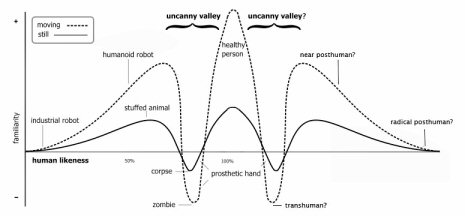The above schematic is an extension of the “uncanny valley” theory that futurist Jamais Cascio proposed in 2008: a “second uncanny valley” that occurs after culture moves into “transhuman” territory.
I like this because it causes us to rethink the structure of “uncanny valley” theory through — uncannily — its mirror reflection, or double image. As an alternate model, it’s quite clever.
The idea also seems sensible, assuming that technology can surmount the (by definition?) impossible hurdle of making a simulacra 100% identical to a healthy person and enter into radical posthumanity.
But the problem I’m having with it is the symmetricality of the model, which seems to simply split along the Y axis in the very “center” of the graph — at the “healthy person” peak. That peak, however, should be the terminus because it is the point where the Other becomes a “mirror image” of the perceiving Self — i.e. an automaton, doll, robot or other animated object that looks (or is otherwise perceived to be) identical to a human being and therefore has surmounted the so-called “uncanny valley” (that sinking feeling in our emotional reaction to the unfamiliar).
The idea in Cascio’s theory is that once we move beyond the pinnacle of the “healthy person” we then ping backwards again, coming “down” from the pinnacle of complete identification into something radically posthuman. If it were moving in the direction of transhuman, would it not rise ABOVE the pinnacle of health in the center of the model? Perhaps transhumanism would be something of a “sublime mountain” instead of an uncanny valley — a reaction in the perceiving subject of awe and wonder about the transcendent human.
And because the transhuman is still a version of the human, I am not so sure that transhumanity would be perceived as Other in the first place. Another way to think of this is this way: What would a posthuman subject apprehend as uncanny? The humanity that it has surmounted? Or something beyond the beyond?
Indeed, the very act of perception would likely be quite different for the transhuman subject and require an altogether post-binary model.
Even so: I love encountering an alternate model that approaches this from a futurist perspective. In The Popular Uncanny, one of my arguments is that the uncanny in postmodernity is really an echo effect of modernist culture — that yesterday’s “automatons” are today’s “cyborgs” — and that the emotional affect of these things is still present, despite the familiarity of such doppelgangers in popular culture. To think of the transhuman is to think beyond the human, and to think of a post-uncanny.
Read the article and the interesting comments about it in Casio’s “Open the Future” blog.

2 comments